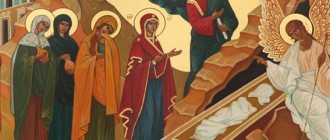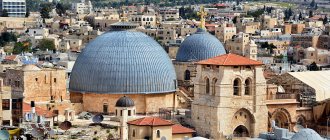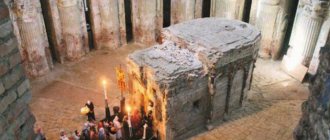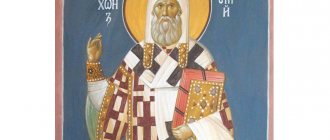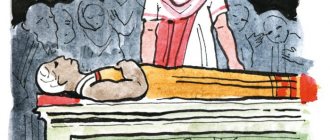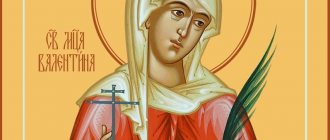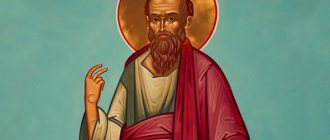The Sunday of the Holy Myrrh-Bearing Women and the Righteous Saints Joseph of Arimathea and Nicodemus is the third week after Easter. It is dedicated to the wives who, on the night of the Resurrection of Christ, hurried to the Holy Sepulcher with peace in their hands to pour fragrant aromas on the Body of the Savior, according to Eastern custom. It is believed that this is a traditional Orthodox “women’s” day.
Week of St. Myrrh-Bearing Women. history of the holiday
On the week of the Myrrh-Bearing Women, the Church remembers the holy women - witnesses of the suffering, death and Resurrection of Jesus Christ. Among the myrrh-bearing women, we know the names of only a few about whom the holy evangelists wrote. The first is Mary Magdalene , it is said about her that the Lord cast out “seven demons” from her (according to the church interpretation, here “seven” means many; “demons” can also be understood as sinful habits that are contrary to the seven basic virtues - the gifts of the Holy Spirit ). The second is Salome , who was the daughter of Joseph the Betrothed and the mother of the holy apostles James and John of Zebedee. The third is Joanna , the wife of Khuzan, the steward of King Herod, the same one who saved the holy head of John the Baptist from desecration. The fourth and fifth are Marya and Martha , the Lazarev sisters. The sixth is Marya Cleopina , whom, according to the laws of Jewish kinship, the evangelist calls the sister of the Most Holy Theotokos, the seventh is Sosana . Among the myrrh-bearing women was also the Most Holy Theotokos , whom the evangelists call “Mary of Jacob” and “Mary of Joseph.” There were many others with them who walked with the Lord during His earthly life and served Him.
The risen Savior was the first to appear to the myrrh-bearing women. From them came the Easter greeting “Christ is risen!” On the night of the Resurrection of Christ, the myrrh-bearing women hurried to the Holy Sepulcher with myrrh in their hands to pour fragrant aromas on the Body of the Savior, according to Eastern custom. The wives, heading to the coffin, thought: “Who will roll away the stone from the coffin?” Before their arrival, as a result of the descent of the Angel, an earthquake occurs, which rolls away the stone and plunges the guards into fear. The angel told the wives that Christ had risen and would precede them to Galilee. First of all, the Lord appeared to His Most Pure Mother. But, as the holy fathers write, so that for the sake of close kinship the miraculous phenomenon would not be subject to some doubt, the evangelists do not announce this directly, but point to Mary Magdalene. Among different evangelists we find some differences in the description of events, but there is no contradiction here, because they write about different times. Evangelist Matthew speaks of the “Sabbath Supper,” when the women did not yet come in peace, but to “see the tomb.” Mark writes about early morning, when the sun had already risen. Mary Magdalene, as the most zealous, came repeatedly, was not afraid to go alone, in the middle of the dark night and despising the danger from the possibility of meeting with armed Roman soldiers: by order of Pilate they were given full power to punish if any of the disciples dared to come to the Holy Sepulcher. The Gospel of John, at the latest, especially emphasizes that Mary Magdalene came to the tomb first. Returning to the apostles Peter and John, she says: “We do not know where they laid Him” (John 20:2). After the apostles Peter and John left, Mary Magdalene remained at the tomb. She thought the body had been stolen and cried. At this time, Christ appeared to her, whom she initially mistook for a gardener. He tells her not to touch Him until he ascends to the Father, and asks her to inform the disciples about His Resurrection. Then, according to Matthew, Mary, returning with the gospel to the disciples, meets the second Mary, and Christ appears a second time, commanding him to again inform all the disciples about the Resurrection. The apostles, having heard about the resurrection of Jesus, did not believe.
Some time after the Resurrection of Christ, after His Holy Ascension, Mary Magdalene, as well as Martha and Mary, the Lazarus sisters, arrived in Rome in order to announce to the reigning emperor Tiberius Caesar the whole truth about past events. They presented him with many gifts and told him about all the miracles and benefits that Christ the Savior had shown among the Jews and how cruelly and inhumanly they condemned Him to death. By order of the emperor, other witnesses were then called, including the centurion Login, who stood at the Cross of the Lord. He had on himself the holy robe of the Lord, which had been given to him by lot, and from it the emperor himself immediately received healing, applying it to the purulent scab on his face. Then the imperial chamber shook and shook, causing all the gold and silver idols there to crumble to dust. Very frightened, Caesar decided to carry out a detailed investigation.
Soon all the lawless murderers were given a fair trial and severe retribution - both Pilate and the Jewish elders. Marya Magdalene later worked a lot in the gospel of Christ, for which she received the title “equal to the apostles” in the church. Having reached old age, she reposed in the Greek city of Ephesus and was buried by the holy Apostle John the Theologian. In 886, under the Greek Emperor Leo the Wise, her relics were solemnly transferred to the Constantinople Monastery of St. Lazarus.
Kontakion, tone 2.
Having commanded the myrrh-bearing women to rejoice, you have commanded the great-grandmothers Eva to weep, O Christ our God by your resurrection. He commanded his apostle to preach, The Savior is risen from the grave.
Library of the Russian Faith Canon to the Holy Myrrh-Bearing Women →
Read online
Names of the Myrrh-Bearing Women
Who are these women who have forever left their memory in history, and in whose honor the Day of Myrrh-Bearing Women was established? Evangelists call different names, but based on the analysis of the texts they left and taking into account the Holy Tradition, which also tells about this event, it is customary to include the following names among them: Mary Magdalene, Mary of Cleopas, Salome, Joanna, Martha, Mary and Susanna. Let's take a closer look at each of the names. The icon of the “Myrrh-Bearing Woman” presents us only with a plot composition compiled on the basis of a gospel event. For more detailed details, let us turn to the Holy Scriptures and Holy Tradition.
Holy Righteous Joseph of Arimathea and Nicodemus
The noble Joseph , as the Holy Scriptures call him, was one of the seventy apostles. He came from the city of Arimathea or Ramatha (Rama) and was a rich and noble member of the Sanhedrin and, like Nicodemus , a secret disciple of Christ. However, when extreme circumstances required it, he courageously revealed his faith and decided to go to Pontius Pilate to ask for the Holy Body of the Lord for burial. As a famous person and known personally to the ruler himself, who also had sufficient funds for ransom, he had the courage to do this. Heeding the prayer of the Most Holy Theotokos, he despised all fears and fears of possible subsequent revenge from the Jewish elders. Having received permission to remove Jesus from the cross, he buried Him in a tomb carved into the rock that belonged to himself. Together with Nicodemus, Joseph wrapped a shroud around Jesus' body. It is believed that the burial in the tomb of Joseph of Arimathea fulfilled the messianic prophecy of Isaiah:
He was assigned a grave with evildoers, but He was buried with a rich man (Isa. 53:9).
After participating in the burial of Christ, Nicodemus, according to Church Tradition, was expelled from Judea. And Joseph of Arimathea was put in chains and thrown into a ditch, from where he was rescued by an Angel. Subsequently, Joseph, as the Holy Tradition says, together with Mary, Martha and their brother Lazarus, whom Christ resurrected, preached the Gospel in Gaul, on the territory of modern France.
Descent from the Cross. Position in the coffin. End of the 16th - beginning of the 17th centuries. State Russian Museum, St. Petersburg
It is believed that Nicodemus is the author of one of the apocryphal Gospels, the time of which has not been established. The oldest parts of the text first appeared in ancient Greek. The “Gospel of Nicodemus” consists of a main part, called the Acts of Pilate, and an appendix to it, the Descent into Hell, which is not in the Greek version of the text, being a later addition in the Latin version.
Joanna and Maria Kleopova
Somewhat more extensive information is available about John. It is known that she was married to one of King Herod’s close associates and was a very rich woman. It is generally accepted that during Christ’s sermons she took upon herself the bulk of the expenses associated with His life and work. In addition, she has another important merit. It was Joanna who secretly buried the head of John the Baptist on Mount Elion, which Herodias threw into a landfill after desecration.
From the limited information about Mary of Cleopas, another glorious follower of Christ, who was included in the number of the Myrrh-Bearing Women, it is known that she was a relative of Jesus, but the opinions of researchers differ on the degree of relationship. According to one version, she was the wife of Cleopas, the brother of Joseph the Betrothed, and according to another, although less probable, she was the sister of the Blessed Virgin Mary.
Feast of the Holy Myrrh-Bearing Women. Icons
The Gospel story about the appearance of an angel to the women at the Holy Sepulcher, representing the first evidence of the Resurrection of the Lord, formed the basis for the early iconography of the Resurrection of Christ. The earliest known icon painting of the Myrrh-Bearing Women at the Holy Sepulcher is in the baptistery at Dura Europos (232/3 or between 232 and 256). The Myrrh-Bearing Women are depicted walking from left to right to the closed Tomb, holding vessels with oil and burning torches in their hands; above the Tomb are two stars symbolizing angels. On the fresco of the vestibule of the funeral complex in the Carmus quarter of Alexandria (second half of the 5th century) an image of a wingless angel sitting in front of the coffin appeared - this was later called “The Appearance of an Angel to the Myrrh-Bearing Women.”
The relief of a silver sarcophagus (IV century) from San Nazaro Maggiore in Milan shows three Myrrh-Bearing Women in front of the Tomb in the form of a building, above which is the figure of a descending angel. On the avoria (c. 400), the tomb is depicted as a two-tiered stone building, with guards leaning on it and sleeping; an angel sits on the left at the half-open door, on the right the Myrrh-Bearing Women approach, above whom the “Ascension of the Lord” is represented.
The Gospel of Ravbula presents a sheet miniature with the compositions “The Appearance of an Angel to the Myrrh-Bearing Women” in the lower part and “The Crucifixion” in the upper part: in the center among the trees, at the same level with their tops, there is a small tomb with a half-open door, the guards in front of the entrance fell to their knees , one recoils from the light coming from behind the door. To the left of the tomb, a winged angel sits on a stone block, announcing the Resurrection of Jesus Christ to two wives, who also stand on the left. In one of them, depicted with a halo, the Mother of God is recognized. Her similar image is presented in the “Crucifixion” scene and is repeated again to the right of the tomb in “The Appearance of Jesus Christ to Mary after the Resurrection.”
|
|
In the XIII-XIV centuries. There are various modifications of the iconography developed in the previous period. They often revive early Byzantine forms of individual objects. On the fresco of the monastery church in Mileshevo (before 1228, Serbia), the Myrrh-Bearing Women are depicted to the right of the angel, whose large figure dominates the composition. The angel, seated on a large marble cubic block in shining white robes, is depicted frontally and looking straight ahead. In his right hand he holds a staff; with his left hand he points to an empty tomb in the form of a vertical rectangular building with a pitched roof and a barred arched opening, inside of which there is a rolled-up shroud. To the right of the stone are small figures of two Myrrh-Bearing Women. In the hands of one is a small censer-katsey. Below are the sleeping guards. On an icon of the 14th century. presented in one composition “The Descent into Hell” and “The Appearance of an Angel to the Myrrh-Bearing Women”; the women are depicted twice: sitting in front of the tomb and standing in front of an angel, who, sitting on a slab, points them to a cave with shrouds.
Myrrh-Bearing Women at the Holy Sepulcher. Spaso-Preobrazhensky Cathedral of the Mirozhsky Monastery, Pskov. Fresco on the east wall of the north transept. Before 1156
In Russian, as well as in Byzantine, monuments, the scene “The Appearance of an Angel to the Myrrh-Bearing Women” is included in the passionate cycles, adjacent to either the “Descent into Hell” or the “Appearance of Christ to the Myrrh-Bearing Women,” and is also found in the festive row of the iconostasis.
In general, the composition follows the scheme developed in the Middle Byzantine period, although various options for depicting the tomb and shrouds, the number of Myrrh-Bearing Women and guards are possible. Thus, in the painting of the Cathedral of the Nativity of the Virgin Mary of the Snetogorsk Monastery (1313), the Wives are traditionally depicted approaching on the left, but the Holy Sepulcher is presented in a very special way: in the form of a rectangular slab under the ciborium, on which two conventionally depicted shrouds lie horizontally in a row. Lamps on chains hang above the coffin. This detail of the composition could reflect the real impressions of pilgrims from visiting the Church of the Holy Sepulcher in Jerusalem and the decoration of the Stone of Anointing.
Myrrh-Bearing Women at the Holy Sepulcher. From the festive ceremony. Vologda. St. Petersburg, State Russian Museum. End of the 15th - beginning of the 16th centuries.
Another version of the iconography “The Appearance of an Angel to the Myrrh-Bearing Women” is presented on the icon from the iconostasis of the Trinity Cathedral of the Trinity-Sergius Lavra (1425). The scene takes place against the backdrop of a mountain landscape. An angel with wings raised vertically is depicted sitting on a round stone next to a diagonally positioned sarcophagus with shrouds, the upper part of which is located in a cave. To the left of the sarcophagus, looking into it, stand three Myrrh-Bearing Women. Their figures are shown in a complex turn towards the angel. This iconographic version, the main feature of which is the image of a rectangular sarcophagus, became especially popular in Russian art.
Myrrh-bearing women at the Holy Sepulcher. From the festive ceremony. Moscow. 1425–1427 Trinity Cathedral of the Holy Trinity Sergius Lavra
The iconography of the plot is similar to the Novgorod tablet icon (late 15th century), only the sarcophagus is located at a different angle. On the icon from the iconostasis of the Assumption Cathedral of the Kirillov Belozersky Monastery (1497) an angel sits at the head of the sarcophagus, there is no cave, the Myrrh-Bearing Women stand on the left, to the right of the sarcophagus are figures of sleeping young men - the guards of the Tomb. On the icons of the 16th century, three warriors in armor are shown sleeping (an icon of the second half of the 16th century), guards are depicted in larger numbers. On the icons XV - beginning XVI centuries the number of Myrrh-Bearing Women was increased to seven, not only at the Tomb, but also in the scene of the appearance of the risen Christ, which was often combined with the plot “The Appearance of an Angel to the Myrrh-Bearing Women” (one of the early examples is the icon from the Gostinopol Monastery, 1457) .
|
|
This iconographic version became widespread in the 16th century. A feature that defined the tradition of Russian art was the image of two angels sitting on round stones at the head and foot of the sarcophagus (icons of the 15th and early 16th centuries). These iconographic types were preserved throughout the 17th-18th centuries.
Appearance of an angel to the myrrh-bearing women. Second half of the 16th century. Yaroslavl Art Museum, Yaroslavl
Appearance of an angel to the myrrh-bearing women. Rostov. End of the 16th - beginning of the 17th centuries. Moscow Kremlin Museums, Moscow.
Icon of the Holy Myrrh-Bearing Women. Annunciation Cathedral in Solvychegodsk, late 16th century.
Saint Theophan the Recluse. Thoughts for every day of the year
Tireless wives! Sleep was not given to the eyes and eyelids until they found the Beloved! And the men seem to rest their feet: they go to the coffin, see it empty, and remain at a loss as to what this means, because they have not seen Himself. But does this mean that they had less love than their wives? No, here was reasoning love, afraid of error because of the high price of love and its subject. When they saw and touched, then each of them confessed not with his tongue, like Thomas, but with his heart: “My Lord and my God,” and nothing could separate them from the Lord.
The myrrh-bearers and the apostles are an image of two sides of our life: feelings and reasoning. Without feeling, life is not life; without reasoning, life is blind, it wastes a lot, but produces little healthy fruit. We need to combine both. Let the feeling move forward and excite; let reasoning determine the time, place, method, and in general the everyday structure of what the heart hints to do. Inwardly the heart moves forward, but in practice it is reasoning. When the feelings become trained in the reasoning of good and evil, then, perhaps, it will be possible to rely on the heart alone; just as shoots, flowers and fruits come of themselves from a living tree, so from the heart only goodness begins to arise, intelligently invested throughout our life.
***
Holy Myrrh-Bearing Women. Paintings
The theme of the Appearance of an Angel to the Myrrh-Bearing Women was addressed by world painters such as Carracci Annibale, Duccio di Buoninsegna, M.V. Nesterov and others.
Maesta. Reverse side. Myrrh-bearing women at the Holy Sepulcher. Duccio di Buoninsegna. 308-11 Siena Cathedral Museum
Myrrh-bearing women at the Holy Sepulcher. Carracci Annibale, 1597-1598
Myrrh-Bearing Women. M.V. Nesterov. 1889
The first witnesses of the resurrection
Photo: Nikola-khamovniki.ru
For their dedication, love and fidelity, the myrrh-bearing women were honored to be the first to see the risen Savior (Matthew 28:9-10). Approaching the Tomb, the wives saw that the stone had been rolled away from the entrance and heard the news from the Angel: “Jesus is Risen!”
“They ran with fear and great joy to tell His disciples that He had risen from the dead” (Matthew 28:7-8).
Subsequently, the myrrh-bearing women, along with the apostles, brought the good news of the Resurrection to the world.
Temples in honor of the Myrrh-Bearing Women
A church in Veliky Novgorod was consecrated in honor of the Holy Myrrh-Bearing Women. The temple was erected in 1510 on the site of a wooden church of the same name that burned down in 1508. It is known that an even earlier building stood here, listed in the chronicle in 1299 as one of 12 burned churches. The construction of the church was ordered and financed by the Novgorod merchant Ivan Syrkov. In 1536, a chapel was built in the name of the Evangelist Matthew, and then in honor of the Presentation of the Lord. At the end of the 16th century, part of the treasury of Ivan the Terrible was kept in the church’s warehouses. Now the temple houses the Regional Children's Cultural Center.
Church of the Myrrh-Bearing Women in Veliky Novgorod
A temple in Pskov was consecrated in honor of the Holy Myrrh-Bearing Women. The stone Myronositskaya Church was built in 1546 in the center of the necropolis, in place of the wooden one in the skudelnitsy (i.e., in a cemetery with common graves of those killed and those who died during the pestilence). It was erected at the expense of the Moscow (at that time Novgorod) Metropolitan Macarius. In 1878, a Edinoverie chapel was built at the church, which has not survived to this day. Myronositskaya Church was closed in the 1930s. In 1989 it was returned to the Russian Orthodox Church.
Church of the Myrrh-Bearing Women from Skudelnice
In the Republic of Mari El, the village of Ezhovo, Tsarevokokshay district, there was the Mironositsky Monastery. Its construction was carried out by order of Tsar Alexei Mikhailovich and is associated with the legend about the appearance of the miraculous icon with the Myrrh-Bearing Women on the site of the future monastery. The icon was delivered to the Tsar in Moscow in 1647 and was subsequently placed in the monastery church. The monastery was founded in the same year, but after the October Revolution it was closed.
In the city of Serpukhov there was a church in honor of the Holy Myrrh-Bearing Women. The first news of the existence of a church here in the name of the Holy Myrrh-Bearing Women dates back to 1552. Around 1685 the temple was built in stone. Myronositskaya Church was destroyed in the 1930s.
There are currently no functioning Old Believer churches in honor of the Holy Myrrh-Bearing Women.
Week of the Myrrh-Bearing Women. Folk traditions
Margoski or Margoskina week - this is what was called in the black earth provinces (for example, in Oryol) the second week after Easter - the week of the Myrrh-Bearing Women. This festival is exclusively for women. Easter eggs acquired special significance here, occupying the main place in the festive ritual. Near Moscow, this women's holiday was expressed in the fact that churches were crowded with married women, widows and girls much more than on any other holiday, and at the same time, each of the worshipers, approaching the cross after mass, made sure to make Christ with the priest and give him an egg , just as at Matins of Easter Sunday the same rite was performed exclusively by men.
In Vyatka, the Myrrh-Bearing holiday was celebrated in its own way and was called “Shapshikha”. The custom boiled down to a women's feast, which was arranged by one of the participants by lot. Most often it was either a widow or a small family. The organizing women were brewing beer and preparing dinner for when the others returned from church. Late in the evening the feast ended with dancing.
Where there were few churches and parishes were located at a considerable distance, on the same Sunday morning, women and girls climbed into the nearby forest, or even to a place where the broom bushes were growing, with ritual offerings in their hands, pockets or bosoms - a couple of raw eggs and a couple of baked and colored ones. They walked with songs, but upon arrival they fell silent, due to the onset of the solemn sacred rite of Christhood and nepotism. Each one took the cross from her neck and hung it on a tree; another came up to him, was baptized, kissed him and exchanged him for her cross; she then kissed his owner, had sex with him - they began to be considered and called “godfathers”, “godmothers” until Spiritual Day. After this, the women sang songs, fried eggs, and drank kvass.
Teenage girls were usually greeted like this: “You just need to grow up and blossom more,” and the bride-to-be girl was told: “Before the raid (next year), you should unbraid your braid in two, so that matchmakers and matchmakers don’t leave the house, so that you don’t sit on the counter.” (in girls), and women were expressed wishes of a different nature: “You will give birth to a son this summer, and that year you will be the third.”
